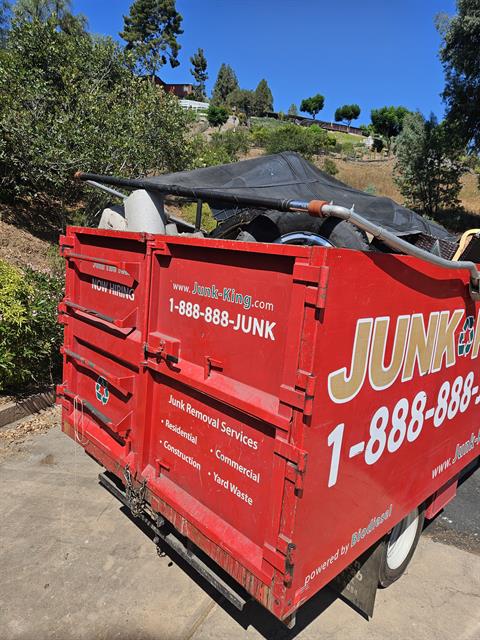After we’ve had our junk hauled away, it begins a fascinating journey through a complex process. Initially, logistics plan efficient collection and transportation. Next, at sorting facilities, advanced technology and manual techniques categorize materials into recyclables, reusables, and waste. Our discarded items might be recycled, upcycled, or even donated, impacting sustainability and economies. But what about hazardous materials or e-waste? Their handling poses unique challenges worth exploring further.
Collection and Transportation
Once you’ve decided to part ways with your unwanted items, the first step is the collection and transportation process, where efficiency and coordination are essential.
We employ various collection methods tailored to the type and volume of junk. For instance, bulk pickup services and specialized containers guarantee streamlined handling.
Transportation logistics play a vital role, involving route optimization and vehicle selection to minimize fuel consumption and time. We prioritize load balancing to maximize vehicle capacity and reduce emissions.
Advanced tracking systems provide real-time updates, enhancing our ability to manage schedules effectively.
Sorting and Categorization
After efficiently collecting and transporting unwanted items, the next step involves sorting and categorizing them to determine their ultimate fate.
We employ various sorting techniques to separate materials based on their composition, size, and recyclability. These techniques often include manual sorting, magnetic separation for metals, and optical scanners for plastics and paper.
Once sorted, categorization methods are applied to classify items into distinct groups such as recyclables, reusables, and waste. This systematic approach guarantees that each category is processed appropriately, maximizing resource efficiency.
Recycling and Resource Recovery
As we explore recycling and resource recovery, sorting and processing facilities play an essential role in managing the materials we discard.
They enable innovations in material reuse, transforming waste into valuable resources.
Sorting and Processing Facilities
At the heart of recycling and resource recovery, sorting and processing facilities play an imperative role in transforming our discarded items into valuable materials.
These facilities employ various sorting methods such as mechanical screening, air classification, and magnetic separation to efficiently categorize materials.
We examine how facility operations optimize throughput and enhance material purity by utilizing advanced technologies like optical sorters and eddy current separators.
By continuously refining these processes, facilities guarantee that the maximum amount of material can be recovered and recycled.
It’s vital that we comprehend how these operations contribute to the circular economy, reducing landfill waste and conserving natural resources.
Through precise sorting and efficient processing, we transform what was once waste into resources ready for reuse.
Material Reuse Innovations
While innovations in material reuse continue to evolve, they fundamentally reshape how we perceive and manage waste. These advancements focus on transforming discarded items into valuable resources, leading to significant waste reduction.
Here are four notable innovations:
- Advanced Material Sorting: Automated systems enhance precision, efficiently separating materials for reuse.
- Biodegradable Alternatives: New materials replace traditional plastics, reducing long-term environmental impact.
- Upcycling Techniques: Creative processes convert waste into higher-value products, extending material life cycles.
- Closed-Loop Systems: Industries redesign processes to reclaim and reuse materials within the same production cycle.
These innovations in material innovation not only decrease waste but also contribute to a circular economy.
Sustainable Disposal Practices
When we focus on sustainable disposal practices, recycling and resource recovery emerge as critical components in managing waste effectively.
By integrating these practices, we contribute to a circular economy, where materials are kept in use, reducing the need for new resources.
Recycling converts waste into reusable materials, minimizing environmental impact and resource depletion.
Resource recovery, on the other hand, extracts valuable materials or energy from waste, further promoting waste minimization.
As we adopt these practices, we reduce landfill reliance and lower greenhouse gas emissions.
This approach demands meticulous sorting and processing, ensuring materials retain their value and usability.
Together, recycling and resource recovery form the backbone of sustainable waste management, aligning with global efforts to enhance environmental sustainability.
Upcycling and Repurposing
Although often overlooked, the process of upcycling and repurposing plays an essential role in waste management and sustainability.
By transforming discarded materials into valuable products, we reduce landfill waste and conserve resources. Creative reuse and DIY projects empower us to rethink the potential of everyday items.
Let’s consider the benefits:
- Resource Efficiency: Upcycling minimizes the need for new raw materials, conserving energy and reducing emissions.
- Economic Value: Repurposed products can meet market demands, offering affordable alternatives and supporting local economies.
- Innovation: Creative reuse fosters innovative thinking, encouraging us to develop novel solutions to environmental challenges.
- Community Engagement: DIY projects cultivate community involvement, promoting awareness and collaboration in sustainable practices.
Donation to Charitable Organizations
When we consider donating items, selecting the right charitable organizations becomes vital to guarantee the goods reach those in need.
Once donations are made, they undergo a thorough processing phase, which includes sorting and evaluating the condition of each item.
Ultimately, these donations have a significant impact on communities by providing essential resources and support to various programs.
Selecting Donation Recipients
How do we determine which charitable organizations receive our donated items? We start by analyzing community needs and aligning them with recipient criteria. This guarantees our donations make the most impact. Here’s how we can approach this process:
- Identify Community Needs: Assess what items are in demand, such as clothing, furniture, or electronics. This helps target where our donations will be most useful.
- Evaluate Recipient Criteria: Different organizations have varying acceptance standards. We must guarantee our items meet these criteria.
- Research Charitable Organizations: Look into their missions, operations, and community impact to guarantee alignment with our goals.
- Prioritize Transparency and Accountability: Select organizations that provide clear reports on how donations are utilized, guaranteeing our contributions effectively address community needs.
Processing Donated Items
After selecting the appropriate charitable organizations, we focus on the efficient processing of donated items to guarantee they meet the specific requirements of each recipient. This involves meticulously adhering to the donation guidelines set forth by our charitable partnerships.
We begin by sorting items into categories, ensuring each aligns with the needs of the recipient organizations. Next, we inspect the condition of the items, confirming they’re in satisfactory shape for donation. Any unsuitable items are redirected to recycling or waste management.
We then package and label each batch for transport, ensuring accurate delivery. Throughout this process, constant communication with our partners is maintained to address any adjustments in guidelines or requests, ensuring a seamless integration of donated items into their programs.
Impact on Communities
The impact of donating items to charitable organizations extends beyond the immediate relief provided to individuals in need; it fosters long-term community development and sustainability.
When we contribute to these organizations, we enhance community engagement and support local initiatives. Here’s how:
- Resource Allocation: Donations enable charities to allocate resources effectively, ensuring that essential items reach those who need them most.
- Economic Stimulation: By redirecting goods to local initiatives, we stimulate micro-economies, creating job opportunities within the community.
- Environmental Benefits: Repurposing items reduces landfill waste, promoting environmental sustainability.
- Social Cohesion: Engaging with charitable efforts strengthens community ties, fostering a culture of support and collaboration.
Through our donations, we play a significant role in building resilient and sustainable communities.
Landfill Disposal and Environmental Impact
When we dispose of our junk, it often ends up in landfills, which play a crucial role in environmental degradation. Landfills are designed to contain waste, but the decomposition process is complex. As organic materials break down anaerobically, landfill methane, a potent greenhouse gas, is released. Methane contributes greatly to climate change, exacerbating global warming.
Effective waste decomposition management can mitigate these emissions, but it requires advanced technology and consistent monitoring.
We must also consider the leachate produced during decomposition, which can contaminate groundwater if not properly managed. While modern landfills incorporate liners and collection systems, older sites may lack these safeguards.
Hazardous Material Handling and Disposal
While managing hazardous materials, we must prioritize safety and environmental protection through meticulous handling and disposal practices.
Understanding hazardous waste management is essential to prevent harm to both people and the planet. Our approach involves adhering to stringent safety protocols, ensuring that every step is executed correctly.
Here’s how we effectively manage hazardous waste:
- Identification: Classify materials to determine if they qualify as hazardous waste, ensuring proper handling.
- Containment: Use suitable containers designed to prevent leaks and spills during transportation and storage.
- Documentation: Maintain thorough records detailing the type, quantity, and disposal method for traceability and compliance.
- Disposal: Employ licensed facilities that specialize in hazardous waste disposal, ensuring environmentally sound practices.
E-Waste Management
How do we tackle the growing challenge of e-waste management? First, we must understand e-waste regulations, which are essential for ensuring safe disposal and recycling.
These regulations often mandate proper handling processes to prevent environmental harm. Compliance with these rules is vital for minimizing toxic waste‘s impact on ecosystems and human health.
Next, we should focus on recycling initiatives. By promoting and participating in these programs, we can divert e-waste from landfills, recovering valuable materials like gold, silver, and rare earth metals.
These initiatives not only conserve resources but also reduce the need for new raw material extraction.
Together, adhering to e-waste regulations and supporting recycling initiatives, we can address this pressing issue effectively and responsibly.
The Role of Technology in Junk Processing
As we explore the role of technology in junk processing, it’s clear that technological advancements have revolutionized how we handle waste materials.
With smart recycling and digital tracking, we’re enhancing efficiency and environmental responsibility. Here’s how technology impacts junk processing:
- Smart Recycling: Automated systems sort and recycle materials more effectively, reducing human error and increasing recovery rates.
- Digital Tracking: Waste materials are tracked throughout their lifecycle, ensuring accountability and optimizing logistics.
- Data Analytics: Analyzing waste patterns helps improve recycling processes and forecast future needs, leading to more sustainable practices.
- Robotics: Machines equipped with AI identify and separate different types of waste, further streamlining the recycling process.
Together, these technologies make junk processing more efficient and environmentally friendly.
Frequently Asked Questions
How Does Junk Removal Impact Local Wildlife Habitats?
When we dispose of junk improperly, it can harm local wildlife habitats. Prioritizing wildlife conservation and habitat restoration guarantees we protect ecosystems. Let’s responsibly manage waste to minimize negative impacts and support ecological balance in our communities.
What Is the Cost Breakdown for Junk Removal Services?
Let’s plunge into a cost analysis. We should compare services by examining labor, transportation, and disposal fees. Each service offers different pricing structures, so understanding these elements helps us make informed decisions and optimize our budget.
Are There Any Legal Regulations for Junk Disposal?
We must comply with junk disposal regulations, guaranteeing proper handling. Legal recycling requirements guide us to separate recyclables from waste. These rules protect the environment and guarantee our community adheres to sustainable practices. Let’s be responsible together.
Can You Request a Specific Disposal Method for Your Junk?
Yes, we can make specific requests for our junk’s disposal. Some services accommodate our disposal preferences, like recycling or donation. It’s crucial to communicate these preferences clearly to guarantee compliance with regulations and service capabilities.
How Do Cultural Differences Affect Junk Disposal Practices?
Cultural attitudes shape our disposal rituals considerably. In some cultures, recycling’s prioritized, while others focus on ceremonial practices. Understanding these differences helps us develop effective, culturally-sensitive waste management strategies that respect diverse practices and environmental goals.


